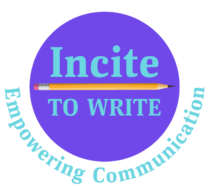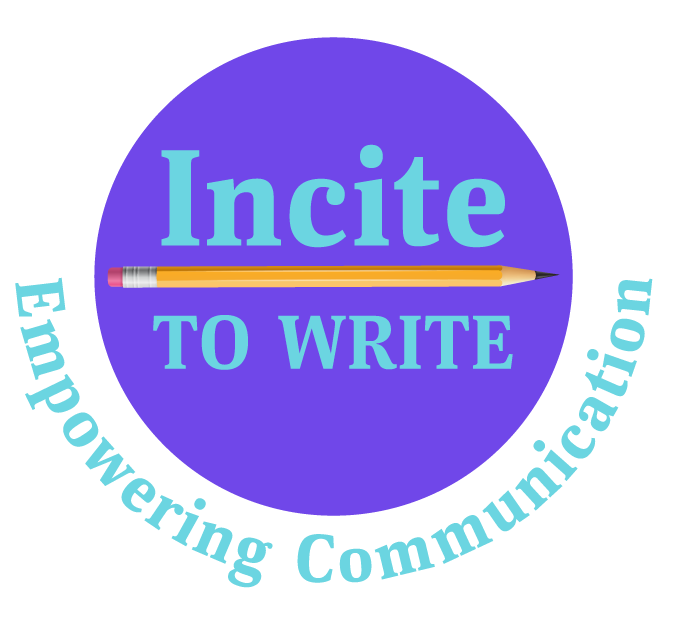EVIDENCE-BASED RESEARCH
Incite to Write consists of over 180 participatory strategies, worksheets, and activities that are designed to accelerate learning in a systematic way and allow for repeated practice opportunities. Instruction is active and interactive, emphasizing a hands-on approach that can be alternately independent and collective. The delivery methods used in the Incite to Write program underscore the empirical rationale that students’ involvement and active participation in their learning is essential and produces a measurable impact on their academic success. All strategies in the program are explicit and identify the common core standard that the activity addresses. Instruction builds on competencies and allows for remedial instruction that targets learning gaps.
Incite to Write’s curriculum addresses Common Core State Standards (CCSS) in ELA (English Language Arts), specifically targeting standards in Writing, Language (Grammar), and Speaking and Listening.
Research has identified that students struggle most with generating ideas and expanding on a theme. Recognizing the need to address this problem, The Incite to Write program provides a wide range of activities and strategies that strengthen critical and creative thinking skills, encourage curiosity, and teach students the process of inquiry – all of which provide students with the skills they need to generate new ideas and expand on topics.
The Incite to Write strategies are supported by rigorous research studies approved by ESSA (Every Student Succeeds Act) and meeting ESSA’s most demanding research level, classified as ESSA Tier 1 Strong Evidence. The following studies meet this level and support Incite to Write activities as follows:
The Study of Effective Writing Practices. This was a large-scale study conducted by the National Center for Education Evaluation and Regional Assistance (NCEE) from 2007 to 2011. The study found that students who received instruction in writing strategies that focused on expanding on a theme or topic showed significant improvement in their writing.
Incite to Write employs a wide variety of question strategies, brain-storming activities and problem-solving exercises to help students increase thinking skills and use their curiosity to generate ideas and expand on a topic. Some of the specific strategies that were successful in the above study and that are used in the Incite to Write program include:
– Brainstorming: Students are taught how to brainstorm ideas by using prompts and questions.
– Organizing: Students are taught how to organize their ideas by using graphic organizers or other planning tools.
– Using evidence: Students are taught how to use evidence to support their ideas by citing sources.
– Revising and editing: Students are taught how to revise and edit their writing by receiving feedback on their writing and by learning how to identify and correct errors.
Further ESSA Tier 1 Strong Evidence supporting the above includes the following studies:
– Learning to Improve: Using Writing to Increase Critical Thinking Performance in General Education, 2007. This study was conducted at the University of California, Berkeley and published in the journal CBE-Life Sciences Education. The study was randomized, controlled, and conducted with a large sample of students. The results of the study were also statistically significant. Authors Quitadamo and Kurtz observed from their research that critical thinking is about curiosity, flexibility, and keeping an open mind. The study found that students who were more engaged with their topic and wrote their own interpretations significantly improved their critical thinking skills in the specific areas of analysis, inference, and evaluation.
The study’s findings are consistent with other research that has shown that writing can be an effective way to improve critical thinking skills. Writing requires students to think about their topic in a deeper way, organize their thoughts coherently, and then communicate them.
The questioning activities used in Incite to Write help students learn to inquire, develop their curiosity, and imagine – skills needed in the development of higher-level thinking. The use of question strategies as a successful and data-driven instruction strategy includes the following evidence, classified as Tier 1, Strong Evidence under ESSA:
- The Power of Questions: How Asking Questions Activates the Learning Brain by Marcia L. Tate (2013): This study provides a comprehensive overview of the research on the power of questions, and how they can be used to activate the learning brain and promote critical and creative thinking. One of the specific Tier I Strong Evidence studies used in this overview is The Effect of Questioning on Student Achievement by Robert J. Marzano (2007). This study found that asking questions can have a significant impact on student achievement, especially when questions are used to activate prior knowledge, promote higher-level thinking, and provide feedback.
- For English Language Learners, the question strategies, process of inquiry and the oral nature of many of the interventions support students as they build language and literacy skills. Integrating oral and written English language instruction is one of the recommendations in Teaching Academic Content and Literacy to English Learners in Elementary and Middle School, released in 2014 by What Works Clearinghouse (WWC) and rated as Tier 1 Strong Evidence.
The Incite to Write curriculum is fun and engaging, and this motivates students to learn. The Incite to Write curriculum employs several instructional interventions that include collaborative writing, such as shared storytelling or assigning students to create different parts of a narrative (i.e., student 1 supplies the characters and setting, student 2 creates a goal and obstacles to the goal, and student 3 creates the solution). These collaborative, shared writing strategies can also be part of pre-planning and pre-writing, an instructional strategy necessary for success in writing.
Other instruction includes creative and visual ways that teach grammar and the structure and organization of the 3 different text types and purposes in Common Core ELA State Standards. Additional writing activities use drama, art, and imagination exercises that include visualizing details so that writing contains a strong degree of specificity. Self-regulation, evaluation, editing and revising encourage students to take ownership of their writing and explore writing as a powerful tool for self-expression. As students take control of their writing process, they experience how language can work for them as a tool that enables them to do things, communicate with others, and express who they are.
The above instructional strategies have proved to be successful and backed by Tier I, Strong Evidence as defined by ESSA, as follows:
- A Meta-Analysis of Writing Instruction for Students in the Elementary Grades, by S. Graham, D. McKeown, S. Kiuhara, K. Harris, 2012. To be included in this analysis, a writing intervention had to be tested in at least 4 different studies. Each study had to be a “true experiment” or quasi-experiment (randomized control trial: random assignment to conditions), and with treatment and control groups having specific criteria and qualifying conditions. Statistics were computed and weighted. The following writing interventions were included among the interventions that showed statistically significant results: – Prewriting and preplanning improved writing quality. All 4 studies demonstrated results that were statistically significant.
- – Peer assistance when writing. Having students work together enhanced writing quality. All 4 studies showed effects that were statistically significant.
- – Adding self-regulation instruction to strategy intervention improved writing quality. All six studies showed statistically significant results.
- – Creativity/Imagery instruction. Teaching students how to be more creative improved writing quality. All four studies showed statistically significant results.
- In Teaching Elementary School Students to be Effective Writers, 2012 and revised in 2018, a practice guide from What Works Clearinghouse (WWC) and rated as Tier I Strong evidence, the following 4 intervention processes were recommended: planning, drafting, sharing, and evaluating.
Writing activities in the Incite to Write curriculum often center on prompts that encourage students to connect to their own life experiences. In many activities, students can choose the topics of their writing. Writing is always edited and corrected and re-written, because it is through the editing and revising process that students learn correct language usage, as well as correct spelling. Sometimes the final version of a piece of writing is laminated to make it special, so the student can take it home and keep it.
The above strategies are supported by the following Tier 1 Strong Evidence study:
- The Writing to Learn (W2L) study was a meta-analysis of studies that examined the effects of writing on learning. The study reviewed 53 studies that included over 10,000 students. The study found that the benefits of writing are greatest when students are writing about topics that they are interested in and when they are given opportunities to revise and edit their work. It also found that writing can help students to develop their creativity and their ability to communicate effectively, and have a positive impact on learning, particularly in the areas of reading comprehension. For example, the studies found that writing can improve students’ understanding of text, their ability to solve problems, and their ability to think critically.
READING
Tier 1 Strong Evidence studies, conducted by the University of Georgia, found that students who used targeted reading strategies for 10 weeks showed significant improvement in their reading comprehension scores on the Gates-MacGinitie Reading Test.
The studies found the following strategies to be effective in improving reading comprehension:
– Summarizing: Students were asked to summarize what they read in their own words. This helped them to identify the main ideas and supporting details of the text.
– Questioning: Students were asked to ask questions about what they read. This helped them to think critically about the text and to engage with the material.
– Visualizing: Students were asked to create mental images of what they read. This helped them to understand the text more deeply and to make connections between the text and their own experiences.
– Making connections: Students were asked to make connections between the text and their own lives, other texts they had read, or current events. This helped them to see the text in a broader context and to understand its relevance to their own lives.
Creating their own questions on the text is a standard strategy used in Incite to Write tutoring. The process leads students into an inquiry and develops higher level thinking skills including summary, prediction, analysis and the integration of knowledge and ideas. Other comprehension strategies include predicting outcomes, creative visualization, and making inferences. Discussion is used frequently to help students interact with the text, clarify their understanding of what they read, and make connections to their own experiences.

How to awaken curiosity and thinking skills - 18 minutes

Activities for when your child or students are stuck, stubborn or scared! - 25 minutes

Activities for expanding on a theme and staying on topic - 20 minutes
These strategies are further supported by the following ESSA Tier 1 Strong Evidence studies:
- In Providing Reading Interventions for Students in Grades 4-9, a What Works Clearinghouse (WWC) practice guide falling in the category of Tier 1, Strong Evidence, comprehension-building interventions included: “Consistently provide students with opportunities to ask and answer questions to better understand the text they read”.
- The Questioning the Author (QA) study is another ESSA Tier I Strong Evidence study. The QA study was a large-scale randomized controlled trial of over 1000 students in grades 4-6. The QA strategy involves teaching students how to ask questions about what they are reading, and then using those questions to guide their thinking and writing. The study found that students who participated in a QA intervention made significantly greater gains in reading comprehension than students who did not participate in the intervention. They had significantly higher scores on standardized tests in reading comprehension and writing, and the benefits persisted for up to one year after the intervention ended.
- Effects of Comprehension Strategy Instruction on the Reading Comprehension of Struggling Readers: A Meta-Analysis (Kieffer & Lesaux, 2007). The studies were conducted over a period of 20 years, from 1985 to 2005, involving 2,890 students with the average age of 11 years. The results of the meta-analysis showed that comprehension strategy instruction had a significant positive effect on the reading comprehension of struggling readers. The comprehension strategy interventions used that were most effective were the following:
- – Reciprocal teaching/Discussions: Reciprocal teaching is a collaborative learning strategy that involves students working together to discuss a text. The students take turns leading the discussion, and they are responsible for asking questions, summarizing the text, clarifying difficult passages, and making predictions.
- – Story mapping: Story mapping is a strategy that helps students to understand the structure of a story. Students create a map of the story, which includes the setting, characters, plot, and conflict. This helps students to identify the important parts of the story and to see how the different parts of the story are connected.
- – Questions/Answering: This strategy helps students to focus on the important parts of a text and to think critically about what they are reading. Students are given questions to answer about the text, and they are responsible for finding the answers in the text. This helps students to learn how to identify the main ideas of a text and to support their answers with evidence from the text.
To conclude, you can be assured that whether you purchase the Incite to Write Modules or participate in on-line Tutoring, your student(s) will be receiving vigorous, science-based learning practices that are researched and evidence-based according to the most rigorous standards of ESSA.







